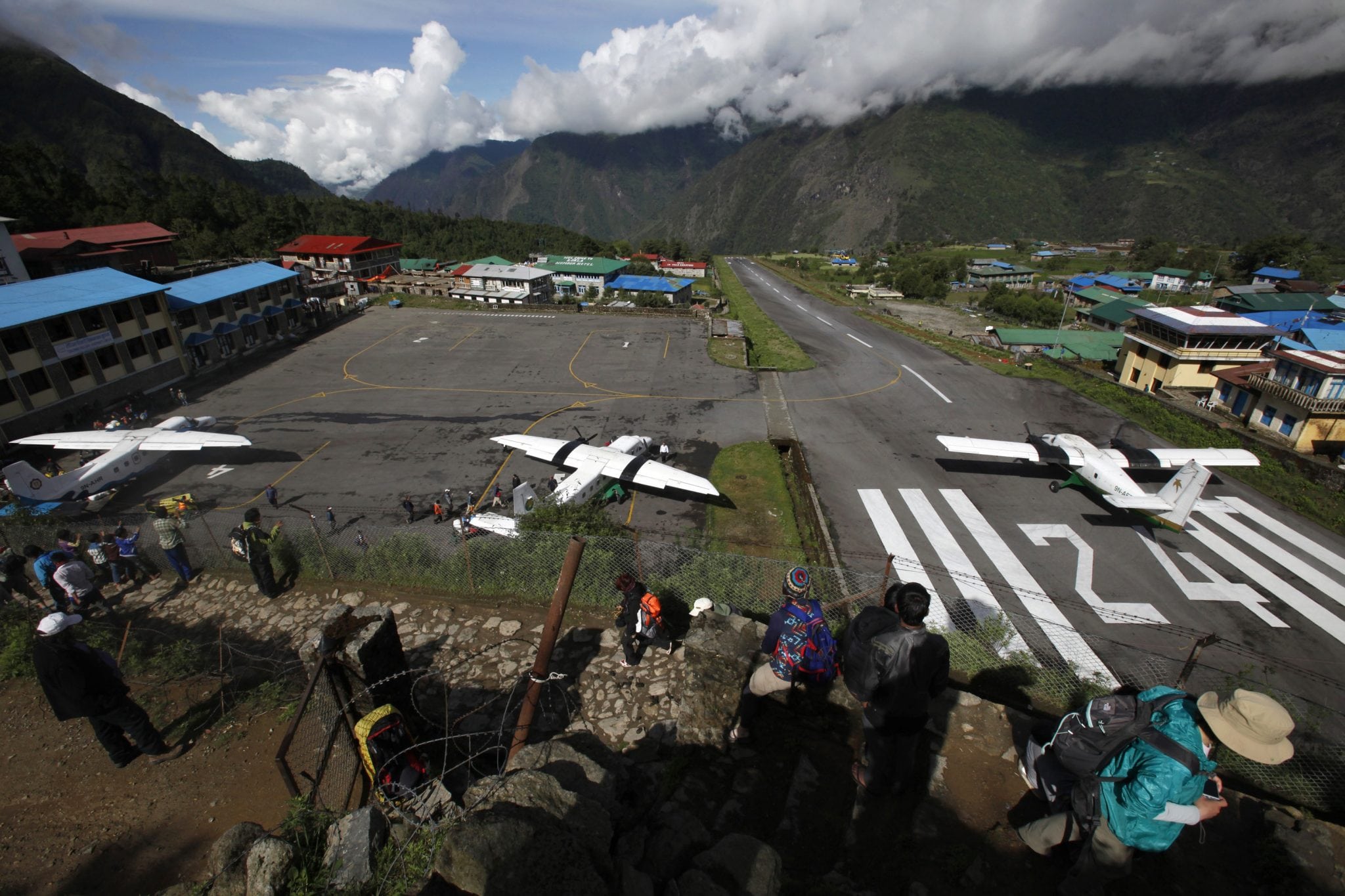Skift Take
The airport has claimed fewer deaths (~50) than Mount Everest (~240) making it the lesser of two risks, but the destination's precarious location provides few opportunities for increasing safety.
As soon as the decades-old Twin Otter landed at Lukla airport, passengers burst out in applause. They do that for nearly every safe landing at the often terrifying airport at the gateway to Mount Everest.
At an altitude of 2,843 meters (9,325 feet), the small airstrip here has earned a reputation as one of the most extreme and dangerous airports in the world. The single runway is narrow, short and sloped. Miss the runway by a few meters (or feet) and the plane would hit a mountain.
“After you cross the river there is no turning back, you have to land,” said Pramod Poudel, a Tara Air pilot who has flown hundreds of these flights to Lukla.
Carved out of the side of a mountain, the airport was built by Sir Edmund Hillary in 1965 — 12 years after he became the first man to conquer the world’s highest peak — to help the local yak herders known as Sherpas spur development in the impoverished area.
Now what once was a dirt strip is one of Nepal’s busiest airports, the Tenzing-Hillary Airport — named as well for Hillary’s climbing partner Tenzing Norgay. The thousands of mountaineers and trekkers who visit the Everest region have to fly to the airport if they want to avoid a daylong bus trip from Katmandu and five days of trekking to reach here.
The airport has handled up to 79 flights on one day — far beyond the acceptable capacity for such a facility, said Rinji, the airport’s air traffic controller, who, like most Sherpas in the Everest region, uses only one name.
“It is really challenging, because of the geographical location of the airport and high mountains that surround it. Topography is challenging and the traffic volume is challenging,” said Rinji. “There is little space for aircraft to maneuver because of the high mountains and narrow valley.”
Poudel, the pilot, said he and his colleagues need to concentrate hard when landing on the single runway, which is less than 500 meters (yards) long, slopes some 12 degrees and is barely 20 meters (65 feet) wide.
“Because there is no way to go around again, we have to calculate many things like air speed, tail wind, fog,” he said. “If you don’t do the proper calculation or proper exercise, then it” — meaning an accident — “happens.”
The airport can only handle special short take-off and landing (STOL) aircraft like the Twin Otter or Dronier that take about 18 passengers. It has room for only four of these planes to be parked at one time.
The runway is one-way for both takeoff and landing. Aircraft have to land from the southwest and take off toward the northeast because at the end of one side of the runway is a mountain. When winds are blowing in an unfavorable direction, all takeoffs and landings have to stop.
Crashes are not uncommon.
In 2008, 18 people were killed when a Twin Otter plane belonging to the domestic Yeti Airlines smashed into the side of the runway and caught fire while trying to land in heavy fog. Investigators said the pilot should not have attempted to land in those conditions.
In August 2010, 14 people were killed when a Dronier belonging to the domestic Agni Air crashed after it was forced to turn around due to bad weather conditions at Lukla. In May 2004, another Yeti Airlines Twin Otter crashed while approaching Lukla, killing all three occupants in an accident blamed on heavy cloud buildup and pilot misjudgment.
One plane was unable to stop on the short runway and smashed into a wall. Another skidded off the runway. A third lost its front landing gear as it tried to land and skidded down the runway, forcing the airport to shut for two days. No one was killed in those crashes.
In addition to trekkers, the flights bring in food, construction materials, beer and other supplies required by the local population in this poor area.
And it has changed life here.
Once a tiny village, Lukla now has 3,000 people, many of them drawn to tourism work. Sherpas wait outside the airport hoping to be hired as porters by trekkers staying in the mountains for anywhere from a few days to a month.
But the burgeoning population attracted by the airport has also created severe drinking water shortages and sewage problems. And when a curtain of fog descends on the airport during the popular October trekking season, flights can be cancelled for days. As many as 2,500 passengers have been left stranded here with little food and no accommodation.
Even on its best days, the airport is open for only a few hours.
A man named Funru said his father once owned the land where the airport sits and helped Hillary dig the airstrip.
“When I first began working at the airport, it used to be nothing like this. It was like a river bank. Every evening we had to collect rocks and fill the potholes so flights could land the next morning,” Funru said.
Gurubacharya contributed to this story from Katmandu.
Copyright (2013) Associated Press. All rights reserved. This material may not be published, broadcast, rewritten, or redistributed.
![]()
The Daily Newsletter
Our daily coverage of the global travel industry. Written by editors and analysts from across Skift’s brands.
Have a confidential tip for Skift? Get in touch
Photo credit: In this Sunday, May 26, 2013 photo, several flights get ready to take off after a couple of days of bad weather disrupted flight services at Lukla airport, Nepal. Niranjan Shrestha / AP Photo
